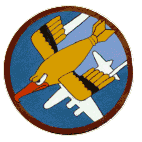
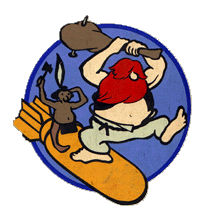
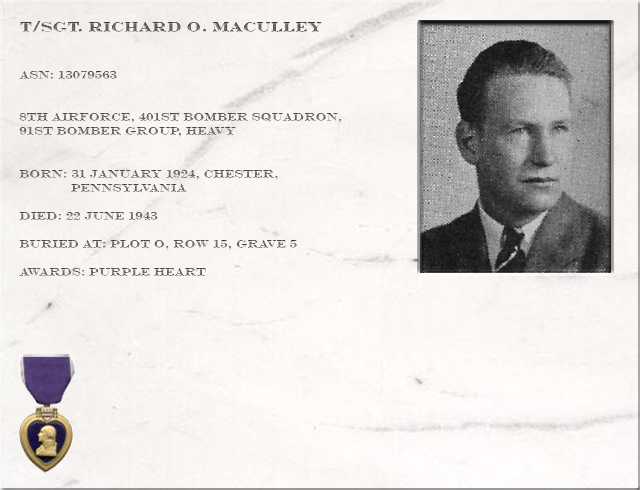
Richard Maculley was
born on January 31, 1924. His parents George and Mary lived in Chester, Delaware,
Pennsylvania. Here Richard grew up together with his brothers Robert and Raymond
and sisters Isabelle and Dorethy. His father worked at Sun oil Co. and died
in an explosion on september 11, 1944. His mother died in 1947.
Richard was a student at Chester High school when the US was drawn into the
war. Hij quit High school and enlisted for the airforce on May 20, 1942. He
was trained for radio-operator and he and the rest of the crew were assigned
to the 91st Bomb group. He left for England to join the 401st squadron. He flew
his first mission on May 14, 1943.
The 91ste Bomb Group (Heavy) was activated on April 15, 1942 on Harding field.
The group had 4 squadrons 322, 323, 324 and 401st squadron. The crews departed
to Gowen field, Idaho on August 24, 1942 after training on McDill field, FL
and Walla Walla airbase. On Gowen field they received their B17's. It took till
October before there were enough B17's available for the group. The first squadron
already departed at the end of September to England. The ground echelon also
left for England in September on the Queen Mary. From October 1942, Bassingbourn,
England was their base.
The first of 340 missions was flown on November 7, 1942. 9591 sorties and 22142
tons of bombs later, on April 25, 1945 the European campaign ended for the 91st
Bomb group. In total they lost 197 aircraft and 1010 crewmembers. They were
awarded with a presidential citation for 2 missions. In June 1945, the 91st
Bomb group returned to the US and was planned for the pacific. When the war
against Japan ended the 91st Bomb group was de-activated on November 7, 1945.
 |
 |
91st
BG patch |
401st
Bomb Sq patch |
On Monday morning the 22nd
of June 1943 the bombers of the 91st Bomb Group departed from their base Bassingbourn
in England. Their target was a chemical plant in Hulst, Germany.
B17 #42-29536 "Mary-Ruth" flown by 1st Lt. Kenneth Brown flew it's
7th mission to Germany. On approach they were attacked by 6 FW190's, lead by
Emil-Rudolf Schnor, wich took off from Schiphol airbase in the Netherlands.
The attack caused heavy damage to the cockpit and engine #4 was on fire. The
"Mary-Ruth" broke out of formation and the Germans fired more 20mm
rounds at the aircraft. 1Lt. Brown gave the order to abandon the plane. T/Sgt.
Akers just left the top turret when this exploded causing exploding munition
to fall in to the cockpit. 1st Lt. Brown fought to keep te plane level while
exploding munition burned his face. The right wing now was completely on fire.
Inside the aircraft the crew did not manage to get the hatch open and they had
to drop 2 bombs so they could leave through the bombdoor. Then the aircraft
exploded and the crew was thrown into the air. 8 of them miraculously survived,
Richard Maculley and William Allen didn't.
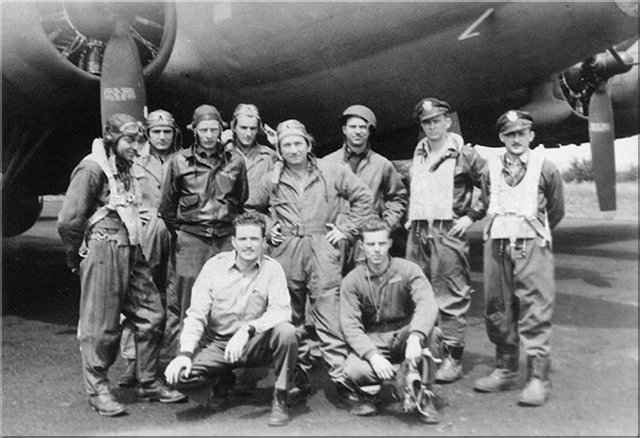 |
|
Crew
of B17 # 42-29536 "Mary-Ruth"
Standing
from the left: |
Maculley and Allen were buried
at the local cemetery of Wulfen, the others were taken prisoner and deported
to different STALAG's. After the war Richard Maculley and William Allen were
brought to the Margraten cemetery. At first Richard Macully was buried at II
- 8 - 197. With the construction of the recent cemetery, after repatriation,
he was finally laid to rest at O - 15 - 5.
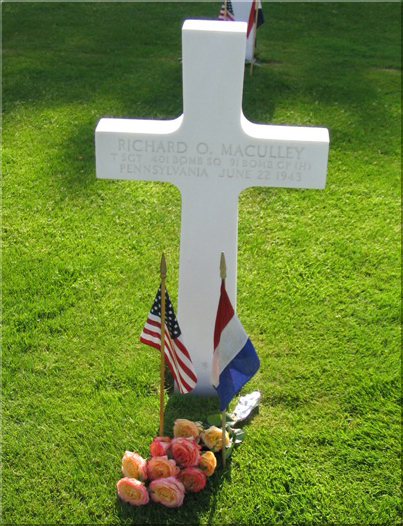 |
Grave
of T/Sgt. Richard O. Maculley |
| A special word of gratitude for sharing information is going out to : Mr. Ron Raaijmakers, caretaker of T/Sgt. Richard O. Maculley's gravesite, He made a webpage about his research, Mary-Ruth on the web Mr. Robert Duijkers, webmaster of the website Field of Stories, where the story originally was published |